浅谈目的论观照下的英汉商标翻译技巧
目的论视角下英文商标汉译研究Analysis of Chinese Translation of T

目的论视角下英文商标汉译研究Analysis of Chinese Translation of Trademark Based on Skopostheorie 5.1 The Fulfilled of SkoposIn order to know how to complete the translation of English trademarks, we must first understand the purpose of English trademarks. English trademarks are often known for their good quality and satisfactory after-sales service. A good brand helps to increase product visibility, prompting consumers to choose the brand's products. In short, the biggest purpose of English trademarks is to establish a good image and stimulate consumers' desire to promote the development of the company. In order to familiarize local consumers with their trademarks, English trademarks mostly choose to translate the trademark into the local language. Usually, the brand owner searches for the translator for translating trademark. The business owner may give the translator a translation summary, which introduces the target consumer, product positioning, product name and other information. The translator translates the trademark based on these information. This newly-produced brand is expected to be functional, so it can only achieve its purpose when accepted by consumers in the Chinese market. The purpose of translation requires translators to do everything possible to make the translation of trademarks popular with target consumers and to cause their desire to buy. If the translated trademark name does not leave a positive impression, or even a negative impression, it is considered an unsuccessful translation. At this point, the initiator either asks the translator to do it again, or find another translator to re-translate. The main purpose of trademark translation is to achieve the expected function of the trademark in China. The uniqueness of trademarks is the main consideration when registering trademarks. Similarly, the distinctiveness and innovation of trademark translation is an important factor for consumers to distinguish similar products.5.1.1 The Informative of Translated TrademarkTrademark is mainly to provide information to potential consumers through advertising and then makes profits. The choice of these consumers will directly affect the performance of the company. This paper raised this question in order to cause the translator to notice that regardless of the amount of information on the originaltrademark, and the translated trademark must have a rich meaning, allowing consumers to understand the product in the shortest possible time, such as the characteristics of the company's services and products. At the same time, the translator should abide by the coherent rules in the discourse, the principle of coherence between texts and the principle of faithfulness. This paper uses some famous British trademark translation cases to illustrate the importance of these rules. For example, Coca-Cola used to be translated into “蝌蚪啃蜡”. This translation violates the Skopostheorie, because the target consumers can infer the true information of the product through this trademark. It is even misleading and completely deviates from the function of the trademark. This translation also violates the coherent rules in the text because the drink cannot be linked to the wax. Customers who see such a trademark will not have any desire to buy. The current translation, “可口可乐”, meets Skopostheorie,and tells consumers that the product is delicious, enjoyable, and consistent with the coherent rules of the discourse, because consumers can understand what the brand is about. Another example is the famous German car brand Benz. Initially it was translated into “彭斯”which made it not outstanding in the market. After that, this strange name was replaced by “奔驰”, and it was a hit. The translation of “彭斯”violates the teleology because it cannot effectively transmit information to the target recipient. Secondly, the word pronunciation is similar to the death in Chinese. It is the most taboo thing in the translation of the vehicle trademark, so it violates the coherence in the text .5.1.2 The Aesthetic Value of Translated Brand NameAs a special language for advertising and marketing, trademarks are most expected to achieve a sense of beauty in the hearts of consumers, leaving a positive impression. This is even more important for those cosmetic labels. Sometimes the original trademark does not have any aesthetic sense, and the translator must use his talents to polish and make it beautiful. An example is the US shampoo brand “ head & shoulders”. The translation of “海飞丝” is recognized as a very successful translation. The reason for its success is that it first meets the rules of teleology, that is thetranslation of “海飞丝” reflects people's need for shampoo. Secondly, it conforms to the coherent rules in discourse, because Chinese consumers can not only understand it, but also understand the beauty of Chinese translation. The Chinese character means “silk flying over the ocean”just like clean shiny hair. Third, this translation is consistent with the coherent rules of discourse because its pronunciation is similar to the original English brand. In short, “海飞丝”, in accordance with the rules of purpose and its two subordinate rules, everyone believes that it has completed the purpose of the brand and created a sense of beauty among the target consumers. Another example is the cosmetics brand Estee Lauder“雅诗兰黛”, which is based in the United States and entered the Chinese market in 1993. The company's goal is to be a world-class product that helps women look young, confident and glamorous. Estee Lauder is the name of its founder, its translation “雅诗兰黛”means elegance, poet, orchid and make-up, and the image of romantic elegance appears in the minds of Chinese consumers. The aesthetic function inspires consumers to purchase its products. Obviously, the brand's goal has been achieved through translation. The translation is also consistent with the coherent rules in the text, and Chinese consumers can feel the elegance and superiority of this makeup brand. In addition, the translation conforms to the coherent rules of discourse because its pronunciation is similar to the original.5.2 Principles Adopted in Chinese Translation of Trademark5.2.1 Attribute Relevance PrincipleAccording to the MSG (Management Study Guide) research, the trademark symbolizes the basic nature of the product, which highlights the physical and individual characteristics of the product. Trademarks also help create brand identity. Skopos theory is the most important theory in trademark translation. It determines the brand characteristics of the translated trademark and the meaning it needs to convey. The ultimate goal is to convince potential customers to purchase the product. The principle of attribute association requires that the translated trademarks enable consumers to associate the brand with impressions of high quality, good service and good reputation, so that customers will buy the product sooner or later. Pavlov's experiment can explain this principle very well. In his experiments, when the doghears the ringtone, it will drool, because they know that there will be meat immediately. Therefore, in the principle of attribute relevance, the translated trademarks should be such that the customer wants to buy the product as soon as he hears the trademark. How we can make a translated trademark famous is a question that requires both the translator and the translator to think together. A successful English trademark translation must not only have a literal meaning, but also be symbolic. Because Chinese is an ideogram, the translated trademarks should sound similar to the original one. That is, the best translated trademark is not only similar to the pronunciation of the original English trademark, but also makes Chinese sound good. The British insurance company "prudential" was translated as “保诚”, and Chinese means protection and sincerity. The translation can tell the customer that the company's insurance business also means that the company will serve customers wholeheartedly. From the perspective of Skopostheorie, “Prudential” first benefits the insurance company to establish a trustworthy image and contribute to the expansion of its business in China. Secondly, it achieves the purpose of conveying positive meaning and is easily accepted and understood by customers. Thirdly, it conforms to the coherent rules of discourse because its pronunciation is similar to the original trademark name, making it easy to associate with the corresponding British brand. Another successful example is the translation of “Johnson & Johnson”,translated as “强生”, which means strengthening for life. From the perspective of Skopostheorie, the translation of this trademark is first in line with the internal consistency rules of the text, because the term “Johnson & Johnson” means that the company's products can improve people's health, and health is the most question people concern. Otherwise, its pronunciation is similar to the original name. Another English trademark "tide" is translated into “汰渍”, which expresses the characteristics of the product well and conforms to the principle of attribute relevance. The brand will associate it with washing powder, in line with the principle of coherence between texts, and of course its pronunciation is similar to the original trademark.5.2.2 Culture Awareness PrincipleBruce Davis Keillor (2007: 94) believes that the language of a country canreflect the culture of that country, show the history of the country, and reveal the way of life and thinking of the people of the country. Translating foreign trademarks is a cross-cultural act, so it is necessary to fully consider the differences between English culture and Chinese culture so that the translation of trademarks can be accepted by local people. This principle of cultural consciousness stems from the coherent rules in discourse, in order to ensure that the recipient of the translated language fully understand the meaning of the translated trademark. Therefore, the translator should fully understand the values of Chinese recipients, including China's social habits, politics and history, and also need to understand the basic expectations of consumers. If the translated trademark does not conform to Chinese culture, it may negatively affect the sales of the corresponding products.For example, the translation of “百事可乐”, the Chinese people like things to go smoothly, and “百事可乐”reflects this characteristic, fully reflects the Chinese culture. At the same time, Coke is also reflected in the translation, indicating that it is a drink, “百事可乐”achieves functional description and cultural expression.5.2.3 Memorability PrincipleThe memory of a trademark can reflect the identity of the trademark. When people remember the trademark, they are more likely to be ready to buy a product or service. The human brain is like a machine that analyzes different information every day. The trademarks are more likely to be accepted by making it easier for customers to remember. Gunter, a Canadian brand strategy consultant, said that good brands that people like to have in their brains usually have the following four characteristics: short; a good trademark preferably has only two syllables. Translated trademarks should also follow this rule. According to the observation, the Chinese trademark should be less than four characters, because if it exceeds four characters, the customer will have a hard time to remember. Second is particularity, if a trademark is different from any others, the consumer's brain will redouble its efforts to remember it. Trademark owners want to create a recognized trademark, so a strong memory brand is crucial. The translation of Kodak and Exxon(柯达和埃克森)are two good examples. These two translated trademarks, different, unique and simple, are subjectto this rule. The third is meaningful; Trademarks can be better remembered when trademarks enable consumers to connect their images with their products. What is different from English is that Chinese is a phonological ideogram. If the translation of the trademark is only to pass the sound to the target recipient, it does not make much sense. A good translation of a good English trademark requires both the pronunciation to be similar to the original one and the positive meaning. The translations of many well-known trademarks such as Pampers, Tide and Goldlion (帮宝适,汰渍,金利来) have done this. The last is feeling emotionally. Scientists have shown that good emotions can help enhance memory. Therefore, any name that can cause emotions is easier to remember. The above examples are all trademarks with emotions. The trademark Unilevel translated into “联合利华”, means to gather together and benefit China, which caters to the patriotic sentiments of Chinese consumers, so they may be more willing to buy it.5.3 Strategies for Chinese Translation of Trademark5.3.1 Major Translation StrategiesSkopostheorie believes that the purpose of translation determines the translation behavior and the translation strategy adopted. The main purpose of the Chinese translation of English trademark is to provide customers with product information, to arouse their interest in the product and to convince them to buy. The translation of English trademarks should strictly abide by this purpose and adopt strategic translations such as transliteration and literal translation.5.3.2TransliterationWiktionary believes that transliteration means finding similar words in the target language based on the letters or word pronunciations in the words, which means better words. It is divided into complete transliteration and homonym.Complete transliteration refers to the translation of words in the target language that are similar to the original words. The use of full transliteration usually has the following conditions. First, the English brand name is not the English proper name and does not have any specific meaning. For example, "Casio" is transliterated into“卡西欧” and "Audi" is transliterated into “奥迪”. Second, the English trademark is made up of coined words. For example, the Japanese film trademark "Codak" was transliterated into “柯达”, and Kodak was meaningless in Chinese. But the pronunciation of "Codak" is somewhat similar to the click sound of a camera, which can help customers to talk about the trademark and the product, and may even purchase the product. The third condition for transliteration is that the English trademark consists of common words. These common words can be translated verbatim, but the translated names do not conform to Chinese customs. For example, if the washing machine trademark "Sharp" is literally translated into "夏普" in Chinese, which sounds unrelated to the washing machine and can mislead consumers. Although the transliteration "夏普" is not a perfect translation, it is still better than “锋利”. The biggest advantage of using full transliteration is that it helps to preserve the phonological beauty of the original brand name, reflecting the true characteristics of the product or exotic. Some people love some high-end trademarks such as Cadillac (凯迪拉克), Hilton (希尔顿), and Rools Royce (劳斯莱斯). Although these Chinese translations are meaningless in Chinese, they cater to the psychology of some people who like Western brands. For them, buying and using foreign top brands symbolizes social status. In summary, it can still find that the fully transliterated trademarks also conform to the Skopostheorie rules, because these trademarks can stimulate consumers' desire to purchase. Of course, these trademark translations do not conform to the coherent rules in the text, because these translated Chinese have no meaning. Of course, the translator needs to pay attention when selecting the corresponding homophones. Words or phrases with negative meanings must be avoided. Some top luxury brands usually use full transliteration because their main customers are those who are wealthy. But for trademarks of common products, full transliteration is not an ideal choice, because these products need to cater to ordinary customers and face a lot of similar products. If foreign products cannot locate themselves in a unique and impressive way and the names are not easy to remember, then the company is likely to face market recession and huge economic losses.5.3.3 TransferenceTransference is another way to represent source text in the target language. These are composed of the initials of the full name, very short, easy to read and understand. The English trademarks that are remembered can be quickly recognized by Chinese consumers and there is no need to translate them into Chinese. The best choice at this time is transference. If the original trademark is simple, eye-catching, and can make a huge profit to the company without translation, you can use transference. Such trademarks were introduced to China without any change in form and pronunciation. For example, AT&T, CD (Christ Dior) and CK (Calvin Klein).5.3.4 Strategy SelectionWhen the translator receives the translation task from the initiator, the translator must use his own translation skills to complete the translation of the trademark in light of the actual situation.First, the decision to use literal translation depends on whether the corresponding Chinese words can be found in Chinese. If so, it is necessary to consider whether such translation can achieve the desired goal. If it is not possible to translate literally, the translator must try to choose a meaning-oriented homophone transliteration method. This translation is impressive and easily accepted by the target consumers. The translation translated by these methods is both practical and in line with the basic principles proposed in this paper. Regardless of the translation strategy used, it is necessary to achieve the purpose of the trademark, the translation strategy establish a good brand image and successfully persuade consumers to make purchases.。
目的论视角下食品商标英译策略

目的论视角下食品商标英译策略
Translating food brand names from a functional perspective
在食品行业中,商标是品牌的重要组成部分。
一个好的商标可以引起消费者的兴趣,增加品牌的知名度和忠诚度。
然而,由于不同国家和地区的文化、语言和法律差异,食品商标的翻译可能会面临各种挑战。
因此,从目的论视角出发,食品商标的英译策略需要考虑以下几个方面。
1. 确定翻译目的
商标翻译的目的可能是为了让消费者更好地理解品牌名称,或者是为了在新的市场中推广品牌。
根据不同的目的,商标翻译的策略也会有所不同。
2. 保持商标的特色
商标的翻译应该尽可能地保持其原有的特色和风格,以便让消费者在不同的语言和文化背景下仍能够识别品牌。
同时,商标翻译还需要遵循目标市场的文化和法律要求,以避免出现不当的字面翻译或语义误解。
3. 考虑语音和语调
商标的发音和语调也是翻译时需要考虑的因素。
在翻译时,应该选择与原商标发音和语调相似的词汇和语言,以便让消费者更容易接受和记忆品牌名称。
4. 选择合适的翻译方式
商标的翻译方式有多种选择,如音译、意译和混合翻译等。
在选择翻译方式时,需要考虑目标市场的文化和语言特点,以及商标的特点和意义。
总之,商标翻译需要综合考虑多种因素,以确保在不同的市场中保持品牌的一致性和可识别性。
从目的论视角看商标翻译
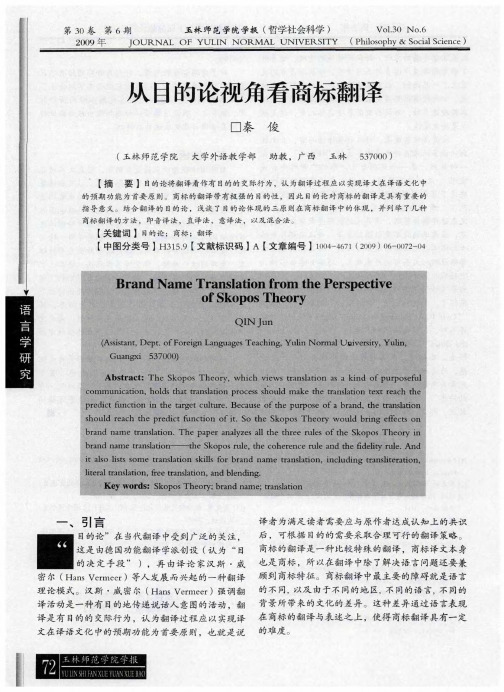
目的论 忠 实性 原 则在 商标 翻译 中的体 现。这 一原 则 类似 于严 复翻 译 标 准 中的 “ ” 。将 忠 实性 原 则应 信
用 于商标 名翻 译 中,我 们 不难推 断 ,商标译 名应 与 源语 商标 名保 持 某种 关联 ,应 当准确传 递 源语 商标
名 的信 息。在 具体 的 商标 名翻 译 时 ,译 文在 保持 自
语 言是 能对译 的 ,所 以 ,译 者作 为翻 译行 为 的 实施 翻译 标 准 中的 “ ”相 似 。翻译 是 一种跨 语 言跨 文 达 者 ,为 了达到 其 目的 ,可 以采 用不 同的翻 译 方法 , 化 的信 息转换 以及 交流 的过程 ,它是 需要 用 另外一
比如 ,音 译 法 、意译 法 ,或 者 自主创 新等 方 法 。例
的产 品 ,直接 决 定 着商标 翻 译行 为 是 否达 到 目的 。
因此 ,商标 翻 译 不能 固守 “ 实” 、 “ 忠 对等 ” 的翻 译 文的 交 际 目的 ;三是使 用特 定翻 译策 略 或翻 译程 序 的 目的 l 2 J 。其 中 ,译 文 的 交 际 目的是 首要 的 。从 译标 准 ,而应 允许 因语 言文 化 的差 异 而采取 不 同的 交 际功 能来 看 ,译文 只要 达 到 了翻译 任 务规 定 的 交 翻译 方法 。商 标翻 译 的 目的性 本 质 意味 着其 译 文必
2 世 纪7 年 代 ,在 德 国兴起 了以凯 瑟琳 娜 ・ 0 O 赖 致 ,让 读 者 能够理 解 。 忠 实性原 则 ,指 译 文既 要 忠 斯 ( ah r a i ) 汉斯 ・ 密尔 ( n emer K tai s 、 n Re s 威 Ha s r e) V 实于原 文 ,又要 忠 实于译 文 读 者和翻 译 的发 起 人 , 以达 到 两者之 间 的平衡 。总 的 来说 ,忠 实法则 应从 贾斯塔 ・ 尔兹曼塔 里 (ut Hoz Ma t r)、克 霍 7s l— nt i a a
从目的论视角看商标英汉翻译-2019年文档
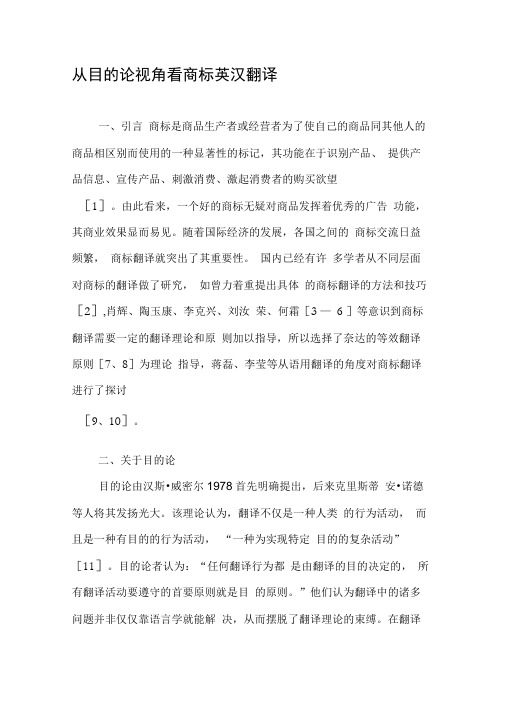
从目的论视角看商标英汉翻译一、引言商标是商品生产者或经营者为了使自己的商品同其他人的商品相区别而使用的一种显著性的标记,其功能在于识别产品、提供产品信息、宣传产品、刺激消费、激起消费者的购买欲望[1]。
由此看来,一个好的商标无疑对商品发挥着优秀的广告功能,其商业效果显而易见。
随着国际经济的发展,各国之间的商标交流日益频繁,商标翻译就突出了其重要性。
国内已经有许多学者从不同层面对商标的翻译做了研究,如曾力着重提出具体的商标翻译的方法和技巧[2],肖辉、陶玉康、李克兴、刘汝荣、何霜[3 —6 ]等意识到商标翻译需要一定的翻译理论和原则加以指导,所以选择了奈达的等效翻译原则[7、8]为理论指导,蒋磊、李莹等从语用翻译的角度对商标翻译进行了探讨[9、10]。
二、关于目的论目的论由汉斯•威密尔1978首先明确提出,后来克里斯蒂安•诺德等人将其发扬光大。
该理论认为,翻译不仅是一种人类的行为活动,而且是一种有目的的行为活动,“一种为实现特定目的的复杂活动”[11]。
目的论者认为:“任何翻译行为都是由翻译的目的决定的,所有翻译活动要遵守的首要原则就是目的原则。
”他们认为翻译中的诸多问题并非仅仅靠语言学就能解决,从而摆脱了翻译理论的束缚。
在翻译中,原文并非衡量一切的标准,忠实原文是次要的,而实现翻译的目的才是首要的。
汉斯•威密尔强调目的论所指的意向性,并不是指活动本身具有意向,而是译者的意向。
目的论将翻译活动视为意向互动、交际行为、跨文化行为及文本处理行为的统一。
三、目的论三个原则在商标翻译中的体现目的性原则的体现,商标翻译是一种目的性很强的翻译行为,其目的在于传递信息,弓I起消费者的注意并吸引他们,刺激他们对产品感兴趣,并最终购买该产品。
因此,商标的翻译目的性很强,就是要达到宣传并刺激消费的目的。
忠实性原则的体现,在商标翻译过程中,译者首先要了解该商标所承载的原语文化、内涵及价值观念等,并充分考虑译语接受者的文化及他们的观念,要了解原商标给他们带来的感受,这样才能确定使用何种方法进行翻译,这就是目的论忠实性原则在商标翻译中的体现。
浅谈目的论视角下的英语商标翻译
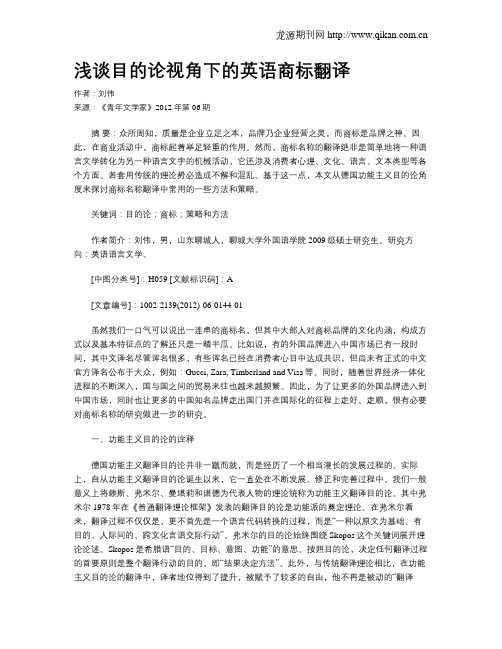
浅谈目的论视角下的英语商标翻译作者:刘伟来源:《青年文学家》2012年第06期摘要:众所周知,质量是企业立足之本,品牌乃企业经营之灵,而商标是品牌之神。
因此,在商业活动中,商标起着举足轻重的作用。
然而,商标名称的翻译绝非是简单地将一种语言文学转化为另一种语言文字的机械活动,它还涉及消费者心理、文化、语言、文本类型等各个方面。
若套用传统的理论势必造成不解和混乱。
基于这一点,本文从德国功能主义目的论角度来探讨商标名称翻译中常用的一些方法和策略。
关键词:目的论;商标;策略和方法作者简介:刘伟,男,山东聊城人,聊城大学外国语学院2009级硕士研究生。
研究方向:英语语言文学。
[中图分类号]:H059 [文献标识码]:A[文章编号]:1002-2139(2012)-06-0144-01虽然我们一口气可以说出一连串的商标名,但其中大部人对商标品牌的文化内涵,构成方式以及基本特征点的了解还只是一鳞半瓜。
比如说,有的外国品牌进入中国市场已有一段时间,其中文译名尽管诨名很多,有些诨名已经在消费者心目中达成共识,但尚未有正式的中文官方译名公布于大众,例如:Gucci, Zara, Timberland and Visa等。
同时,随着世界经济一体化进程的不断深入,国与国之间的贸易来往也越来越频繁。
因此,为了让更多的外国品牌进入到中国市场,同时也让更多的中国知名品牌走出国门并在国际化的征程上走好、走顺,很有必要对商标名称的研究做进一步的研究。
一、功能主义目的论的诠释德国功能主义翻译目的论并非一蹴而就,而是经历了一个相当漫长的发展过程的。
实际上,自从功能主义翻译目的论诞生以来,它一直处在不断发展、修正和完善过程中。
我们一般意义上将赖斯、弗米尔、曼塔莉和诺德为代表人物的理论统称为功能主义翻译目的论。
其中弗米尔1978年在《普通翻译理论框架》发表的翻译目的论是功能派的奠定理论。
在弗米尔看来,翻译过程不仅仅是,更不首先是一个语言代码转换的过程,而是“一种以原文为基础、有目的、人际间的、跨文化言语交际行动”。
从目的论角度分析外国化妆品商标汉译
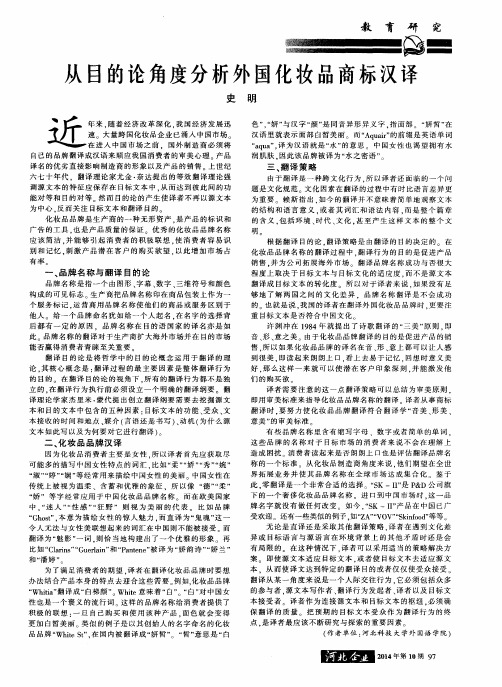
、
品牌名 称与 翻译 目的论
品 牌 名 称 是 指 一 个 由 图形 、 字幕 、 数字 、 三维 符 号 和颜 色 构 成 的 可 见 标 志 生 产商 把 品牌 名 称 印在 商 品 包 装 上 作 为 一 个服务标记 . 运 营 商 用 品 牌 名 称 使 他 们 的商 品或 服务 区别 于 他人 。 给 一 个 品牌 命 名 犹 如 给一 个 人 起 名 . 在 名 字 的选 择 背 后 都 有 一 定 的 原 因 .品 牌 名 称 在 目的语 国家 的译 名 亦 是 如 此 品牌 名 称 的 翻译 对 于 生 产 商 扩 大 海 外 市 场并 在 目的 市 场 能否 赢 得 消 费者 青 睐至 关 重 要 翻 译 目的 论 是 将 哲 学 中 的 目的 论 概 念 运 用 于 翻 译 的理 论. 其 核心概念是 : 翻 译 过 程 的 最 主 要 因 素 是 整 体 翻 译 行 为 的 目的 。 在 翻 译 目的 论 的视 角 下 。 所 有 的 翻 译 行 为 都 不 是 独 立的. 在 翻译 行 为 执行 前 必 须 设 立 一 个 明确 的翻 译 纲 要 翻 译理论学 家杰里米 . 蒙 代 提 出 创 立 翻 译 纲 要 需 要 去 挖 掘 源 文 本 和 目的 文 本 中包 含 的 五 种 因素 : 目标 文 本 的功 能 、 受众 、 文 本接 收的时间和地点 、 媒介 ( 言 语 还 是 书写 ) 、 动 机( 为 什 么 源 文 本 如 此 写 以及 为 何 要 对 它 进 行 翻 译 )
明。
根 据 翻译 目的 论 . 翻译 策 略 是 由 翻译 的 目的决 定 的 在 化 妆 品 品牌 名 称 的 翻 泽 过 程 中 . 翻译 行 为 的 目的是 促 进 产 品 销售 . 并 为 公 司 拓 展 海 外 市 场 。翻 译 品牌 名 称 成 功 与 否很 大 程 度 上 取 决 于 目标 文 本 与 目标 文 化 的 适 应 度 . 而不 是 源文 本
从目的论视角析化妆品商标名翻译汉译技巧
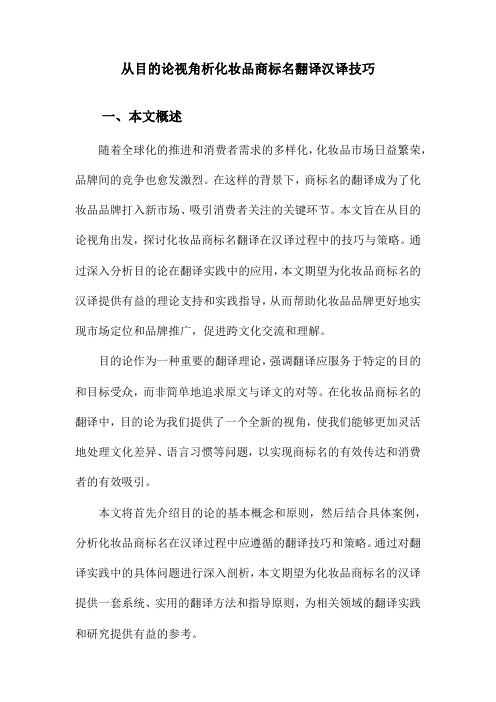
从目的论视角析化妆品商标名翻译汉译技巧一、本文概述随着全球化的推进和消费者需求的多样化,化妆品市场日益繁荣,品牌间的竞争也愈发激烈。
在这样的背景下,商标名的翻译成为了化妆品品牌打入新市场、吸引消费者关注的关键环节。
本文旨在从目的论视角出发,探讨化妆品商标名翻译在汉译过程中的技巧与策略。
通过深入分析目的论在翻译实践中的应用,本文期望为化妆品商标名的汉译提供有益的理论支持和实践指导,从而帮助化妆品品牌更好地实现市场定位和品牌推广,促进跨文化交流和理解。
目的论作为一种重要的翻译理论,强调翻译应服务于特定的目的和目标受众,而非简单地追求原文与译文的对等。
在化妆品商标名的翻译中,目的论为我们提供了一个全新的视角,使我们能够更加灵活地处理文化差异、语言习惯等问题,以实现商标名的有效传达和消费者的有效吸引。
本文将首先介绍目的论的基本概念和原则,然后结合具体案例,分析化妆品商标名在汉译过程中应遵循的翻译技巧和策略。
通过对翻译实践中的具体问题进行深入剖析,本文期望为化妆品商标名的汉译提供一套系统、实用的翻译方法和指导原则,为相关领域的翻译实践和研究提供有益的参考。
二、目的论概述目的论(Skopostheorie)是德国功能主义翻译理论的核心概念,由汉斯·弗米尔(Hans J. Vermeer)和凯瑟琳娜·莱斯(Katharina Reiss)等学者于20世纪70年代提出。
目的论强调翻译行为的目的性,即翻译活动应以实现译文在目标语言文化环境中的预期功能或目的为首要原则。
这一理论突破了传统等值翻译理论的束缚,认为翻译不仅仅是语言层面的转换,更是一种跨文化、跨语言的交际行为。
在目的论框架下,翻译的过程被视为一种有目的的、结果导向的行为。
译者需要根据译文的预期功能或目的,灵活选择翻译策略和方法,以实现最佳的交际效果。
因此,目的论强调译者的主体性和创造性,允许译者在翻译过程中进行适当的调整和创新。
对于化妆品商标名的翻译而言,目的论提供了一个全新的视角。
关于从目的论谈商标翻译方法【分享】

关于从目的论谈商标翻译方法论文关键词:目的论商标翻译翻译方法论文摘要:商标是商品经济发展的产物,它在开拓市场、刺激消费、创造企业财富等方面起着不容忽视的作用。
随着中国经济的发展和全球化进程的加快,世界各国间的经济交往越来越频繁。
在激烈的国际市场竞争中,商标,作为商品的标志,其名称的翻译变得越来越重要。
本文以费米尔的目的论为理论指导,从功能派理论的角度分析了商标翻译过程中所选用的翻译方法及其目的性,指出了商标翻译是一个有目的、复杂的选择过程。
而目的论对商标翻译中所呈现出的各种复杂现象提供了理论解释。
因此本文认为在商标翻译中,应推行目的论指导下的灵活的翻译策略。
引言随着中国经济的发展和经济全球化进程的加快,世界各国间的经济交往越来越频繁。
在这种经济全球化的浪潮下,各个国家的很多大公司都不遗余力地要把自己的产品或服务推向国际市场,各种产品在市场上的竞争愈演愈烈。
现代企业的竞争不再仅仅是商品品质的竞争,而逐步变成了品牌的竞争。
因此,商标作为商品的标志,其翻译的成败对于一个企业及其产品能否成功进入国际市场起着至关重要的作用。
国内外的很多学者都致力于商标翻译的研究,也取得了很多可喜的成绩。
但是,这些学者的视角大多是从语言或文化角度对商标翻译进行探索和研究的,从翻译理论上对商标翻译的研究不多。
本文以费米尔的目的论为理论指导,将从功能派理论的角度分析商标翻译过程中所选用的翻译方法及其目的性,具体分析商标翻译这一有目的、复杂的翻译策略选择过程。
一、商标和商标翻译商标是商品经济发展的产物,它是随着商品经济的发展与演变而产生和发展起来的一种商业性标志。
那么,什么是商标呢?世界知识产权组织(World Intellectual Property Organization)对商标的定义是:“商标是用来区别某一工业或商业企业或这种企业集团的商品的标志。
(贺川生,1997: 2) ”具体来说,所谓商标,就是商品生产者或经营者为了使0己生产或销售的商品或服务在市场上同其他商品生产者或经营者的商品或服务相区别而使用的一种标记。
从目的论视角看商标翻译
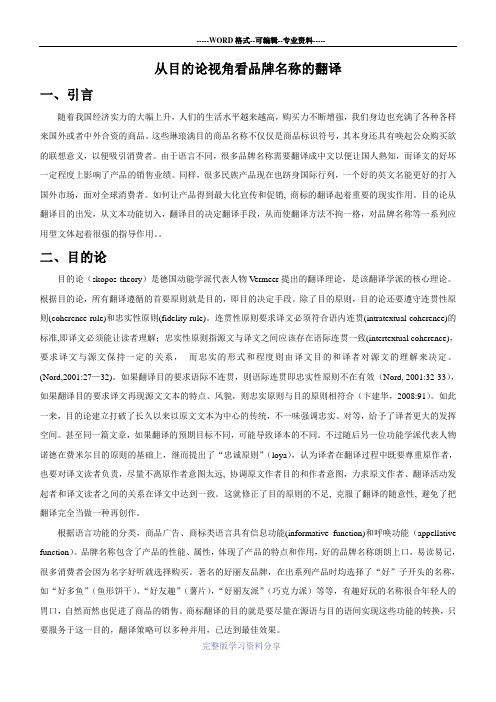
从目的论视角看品牌名称的翻译一、引言随着我国经济实力的大幅上升,人们的生活水平越来越高,购买力不断增强,我们身边也充满了各种各样来国外或者中外合资的商品。
这些琳琅满目的商品名称不仅仅是商品标识符号,其本身还具有唤起公众购买欲的联想意义,以便吸引消费者。
由于语言不同,很多品牌名称需要翻译成中文以便让国人熟知,而译文的好坏一定程度上影响了产品的销售业绩。
同样,很多民族产品现在也跻身国际行列,一个好的英文名能更好的打入国外市场,面对全球消费者。
如何让产品得到最大化宣传和促销, 商标的翻译起着重要的现实作用。
目的论从翻译目的出发,从文本功能切入,翻译目的决定翻译手段,从而使翻译方法不拘一格,对品牌名称等一系列应用型文体起着很强的指导作用。
二、目的论目的论(skopos theory)是德国动能学派代表人物Vermeer提出的翻译理论,是该翻译学派的核心理论。
根据目的论,所有翻译遵循的首要原则就是目的,即目的决定手段。
除了目的原则,目的论还要遵守连贯性原则(coherence rule)和忠实性原则(fidelity rule)。
连贯性原则要求译文必须符合语内连贯(intratextual coherence)的标准,即译文必须能让读者理解;忠实性原则指源文与译文之间应该存在语际连贯一致(intertextual coherence),要求译文与源文保持一定的关系,而忠实的形式和程度则由译文目的和译者对源文的理解来决定。
(Nord,2001:27—32)。
如果翻译目的要求语际不连贯,则语际连贯即忠实性原则不在有效(Nord, 2001:32-33),如果翻译目的要求译文再现源文文本的特点、风貌,则忠实原则与目的原则相符合(卞建华,2008:91)。
如此一来,目的论建立打破了长久以来以原文文本为中心的传统,不一味强调忠实、对等,给予了译者更大的发挥空间。
甚至同一篇文章,如果翻译的预期目标不同,可能导致译本的不同。
目的论视角下化妆品商标汉译技巧
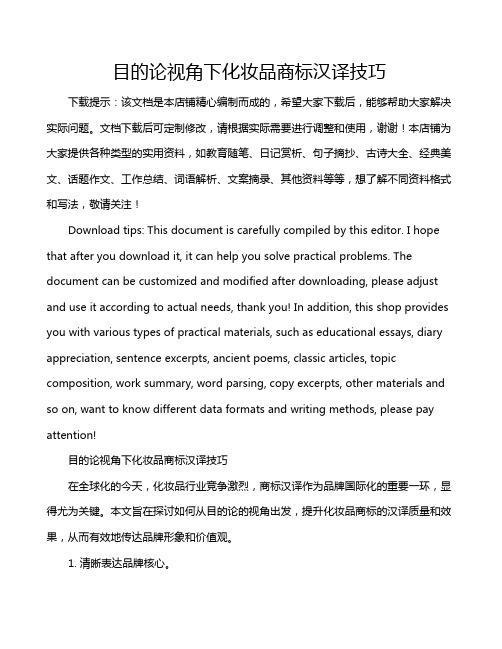
目的论视角下化妆品商标汉译技巧下载提示:该文档是本店铺精心编制而成的,希望大家下载后,能够帮助大家解决实际问题。
文档下载后可定制修改,请根据实际需要进行调整和使用,谢谢!本店铺为大家提供各种类型的实用资料,如教育随笔、日记赏析、句子摘抄、古诗大全、经典美文、话题作文、工作总结、词语解析、文案摘录、其他资料等等,想了解不同资料格式和写法,敬请关注!Download tips: This document is carefully compiled by this editor. I hope that after you download it, it can help you solve practical problems. The document can be customized and modified after downloading, please adjust and use it according to actual needs, thank you! In addition, this shop provides you with various types of practical materials, such as educational essays, diary appreciation, sentence excerpts, ancient poems, classic articles, topic composition, work summary, word parsing, copy excerpts, other materials and so on, want to know different data formats and writing methods, please pay attention!目的论视角下化妆品商标汉译技巧在全球化的今天,化妆品行业竞争激烈,商标汉译作为品牌国际化的重要一环,显得尤为关键。
从目的论视角看商标翻译

从目的论视角看品牌名称的翻译一、引言随着我国经济实力的大幅上升,人们的生活水平越来越高,购买力不断增强,我们身边也充满了各种各样来国外或者中外合资的商品。
这些琳琅满目的商品名称不仅仅是商品标识符号,其本身还具有唤起公众购买欲的联想意义,以便吸引消费者。
由于语言不同,很多品牌名称需要翻译成中文以便让国人熟知,而译文的好坏一定程度上影响了产品的销售业绩。
同样,很多民族产品现在也跻身国际行列,一个好的英文名能更好的打入国外市场,面对全球消费者。
如何让产品得到最大化宣传和促销, 商标的翻译起着重要的现实作用。
目的论从翻译目的出发,从文本功能切入,翻译目的决定翻译手段,从而使翻译方法不拘一格,对品牌名称等一系列应用型文体起着很强的指导作用。
二、目的论目的论(skopos theory)是德国动能学派代表人物Vermeer提出的翻译理论,是该翻译学派的核心理论。
根据目的论,所有翻译遵循的首要原则就是目的,即目的决定手段。
除了目的原则,目的论还要遵守连贯性原则(coherence rule)和忠实性原则(fidelity rule)。
连贯性原则要求译文必须符合语内连贯(intratextual coherence)的标准,即译文必须能让读者理解;忠实性原则指源文与译文之间应该存在语际连贯一致(intertextual coherence),要求译文与源文保持一定的关系,而忠实的形式和程度则由译文目的和译者对源文的理解来决定。
(Nord,2001:27—32)。
如果翻译目的要求语际不连贯,则语际连贯即忠实性原则不在有效(Nord, 2001:32-33),如果翻译目的要求译文再现源文文本的特点、风貌,则忠实原则与目的原则相符合(卞建华,2008:91)。
如此一来,目的论建立打破了长久以来以原文文本为中心的传统,不一味强调忠实、对等,给予了译者更大的发挥空间。
甚至同一篇文章,如果翻译的预期目标不同,可能导致译本的不同。
目的论视角下英文商标词的翻译
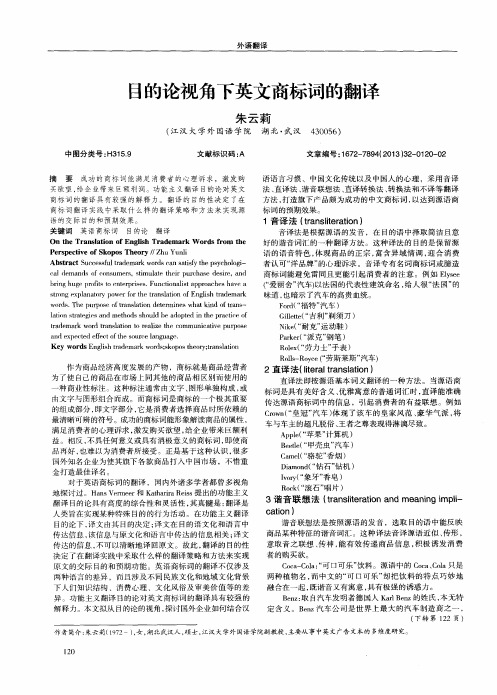
Ke y wo r d s E n g l i s h t r a d e ma r k w o r d s ; s k o p o s t h e o r y ; t r a n s l a t i o n
作为商品经济高度发展 的产 物 ,商标就是商 品经营者 为了使 自己的商品在市场上 同其他 的商 品相 区别而使用 的 种商业性标注 。这种标 注通 常由文字 、 图形单独构成 , 或 由文字与图形组合而成 。而商标 词是商标 的一个极其重要
语语 言习惯 、中国文化传统 以及 中国人 的心 理 ,采用音译 法、 直译法 、 谐音联想法 、 直译转换法 、 转换法 和不译等 翻译 方法 , 打造 旗下产品颇为成功 的中文商标词 , 以达到源语 商 标词的预期效果。
1音译 法 ( t r a n s l i t e r a t i o n)
摘 要 成 功 的 商 标 词 能满 足 消 费 者 的心 理 诉 求 ,激 发 购 买欲望 , 给企 业带来 巨额利润。功能主义翻译 目的论对 英文 商标词 的翻译具有较 强的解 释力。翻译 的 目的性决定 了在 商标词翻译 实践中采取 什么样的翻译 策略和方法来 实现源 语 的交 际 目的 和 预 期 效果 。 关 键 词 英 语 商 标 词 目的论 翻译
t r a d ema r k wo r d t r a n s l a t i o n t o r e a l i z e t he c o mmuni c a t i v e pu r p o s e a n d e x p e c t e d e f f e c t o f t h e s o u r c e l a ng u a g e .
wo r d s . T h e p u r p o s e o f t r a n s l a t i o n d e t e r mi n e s w h a t k i n d o f t r a n s - l o t i o n s t r a t e g i e s a n d me t h o d s s h o u l d b e a d o p t e d i n t h e p r a c t i c e o f
目的论视角下的商标翻译以鞋服商标为例

目的论视角下的商标翻译以鞋服商标为例一、本文概述随着全球化进程的不断推进,商标翻译在商业活动中扮演着越来越重要的角色。
作为品牌识别的核心元素,商标翻译不仅关乎到企业在国际市场的形象和认知度,更直接影响到产品的销售和推广。
特别是在鞋服行业,商标翻译的重要性尤为突出,因为这一领域的市场竞争尤为激烈,商标的独特性和文化内涵往往成为吸引消费者的关键因素。
本文旨在从目的论视角出发,探讨鞋服商标的翻译策略和方法。
通过对现有文献的梳理和案例分析,本文旨在揭示目的论在商标翻译中的适用性,并为实践者提供有益的参考和启示。
本文的研究不仅有助于丰富和完善商标翻译的理论体系,也有助于推动鞋服行业的国际化进程和品牌形象建设。
二、目的论概述目的论(Skopos Theory)是一种源自德国的功能主义翻译理论,由汉斯·弗米尔(Hans Vermeer)在20世纪70年代提出,并由其后的学者进一步发展和完善。
该理论强调翻译活动应以翻译目的为首要原则,即翻译方法和策略的选择应服务于翻译的预期目的或功能。
在目的论框架内,翻译不再被视为单纯的语言转换,而是一种有目的的跨文化交际行为。
目的论认为,翻译过程中的核心问题是确定译文的预期功能或目的,这直接决定了翻译的策略和方法。
弗米尔提出了翻译行为的三大原则:目的原则(Skopos Rule)、连贯原则(Coherence Rule)和忠实原则(Fidelity Rule)。
其中,目的原则是首要原则,它要求翻译行为所要达到的目的决定整个翻译行为的过程。
连贯原则指的是译文必须内部连贯,即译文应符合译入语的语言规范和表达习惯,使译文读者能够理解。
忠实原则则是指原文与译文之间应该存在语际连贯,即译文应忠实于原文,但这种忠实并非逐字逐句的对应,而是指译文应传达原文的意图和信息。
在商标翻译中,目的论提供了重要的理论支撑。
商标作为品牌形象的核心组成部分,其翻译的目的往往是为了在目标市场中建立品牌认知、传递品牌价值和促进产品销售。
目的论视角下看英汉商标翻译

译应遵循 目的论的原则,以 “ 信息、文化 、审美、联想 ”等作为衡量英汉 商标翻译成功与否 的标准,
灵活选用 “ 音译、直 译、臆造 、缩译 ”等翻译策 略。
关键词 :目的论;商标翻译 ;翻译标准 ;翻译策 略 中图分类号:G6 2 4. 0 文献标识码 :B
Tr n lto fEn l h & Ch ne eBr nd a e r m r p c ieo a sa i n o g i s i s a n m sfo Pe s e tv f
文章编号:10 —3 4 (0 0 3 0 5 — 3 0 8 5 9 2 1 )0— 0 2 0
目的论视 角下看英汉商标翻译
王 雪霜
( 天津农学院 人文社会科学系 ,天津 3 0 8 ) 034 摘 要 :商标起 着宣传产 品的作用 ,目的是促成消费者购 买行为 的发生 ,这一 目的性决定了商标翻
国商 品涌 入 中 国市场 , 同时 中 国商 品也不 断进 入 国际 市场 参与 竞争 。若 想 使一 种 商 品在 国际化 市
场 竞 争 中赢 得 不 同地 区 消费者 的青睐 ,除 严格 保 证 其 商 品质 量 外 ,其 商标 也在 国际贸 易 中扮演 着
中 的参照 系数 不应 是对 等 理论 中所 注 重 的原文及
Ke r s S o o e r ; r d a s r sai n t n lt np n i l ;r sai n s a g y wo d : k p s h o t y b a n me a lt ; a s i r cp e ta lt  ̄ t y n tn o r ao i n o e
标 准和 策略 。
灵活 选择 各 种 翻译 方 法 ”I。 目的论并 非 强调 译 1 】
浅析目的论视角下的化妆品商标汉译

交流浅析目的论视角下的化妆品商标汉译张秋辰 山东科技大学外国语学院摘要:随着全球化经济的发展,越来越多的外国化妆品品牌入驻中国。
在化妆品种类日趋多样化的今天,独具特色的商标直接决定着化妆品能否在同类商品中脱颖而出。
因此,化妆品的商标翻译对其品牌在中国的发展有着重大意义。
在此背景下,目的论对化妆品商标翻译有积极的指导意义,因此本文将以目的论的视角,探讨化妆品商标汉译的方法。
关键词:目的论;商标;化妆品;翻译策略商标是打开产品销售的第一扇大门。
外来商标的汉译名称能否凸显产品特色,是否独具匠心,直接决定着化妆品能否在同类商品中脱颖而出。
鉴于目的论是从目的语视角进行翻译的一种理论模式,因此相对于传统翻译理论,它能很好地在翻译的过程中既注重翻译的明确的目的,又注重翻译的实用性。
一、指导化妆品商标汉译的目的论目的论始于二十世纪七十年代兴起的德国功能学派,其代表人物有该理论的创始人赖斯和他的学生威密尔,以及后来进一步发展了目的论的曼塔利和诺德。
目的论共有三个核心原则,即目的原则、连贯原则和忠实原则,其翻译的核心原则就是目的原则(skopos rule),即“任何翻译行为都是由翻译的目的决定的,所有翻译活动所要遵循的首要原则就是目的原则,即目的决定翻译策略”。
[1]因此以目的论为指导的商标翻译策略必须服务其翻译的目的。
相对于化妆品商标翻译而言,促进销售,增加知名度无疑是其翻译的最终目的。
商标是商品的标志,好的商标能起到宣传商品的作用。
商标翻译成功与否的标准之一在于是否实现了宣传商品的目的。
[2]在此背景下,目的论对化妆品商标翻译有积极的指导意义。
本文将以目的论的视角,探讨化妆品商标汉译的策略。
二、目的论指导下的翻译策略关于商标翻译,美国广告大师E·S·路易斯在1989年提出了著名的AIDA原则,即成功的广告应具备:Attention引人注意,Interest产生兴趣,Desire引发欲望,Action激发行动。
从目的论看英汉商标翻译
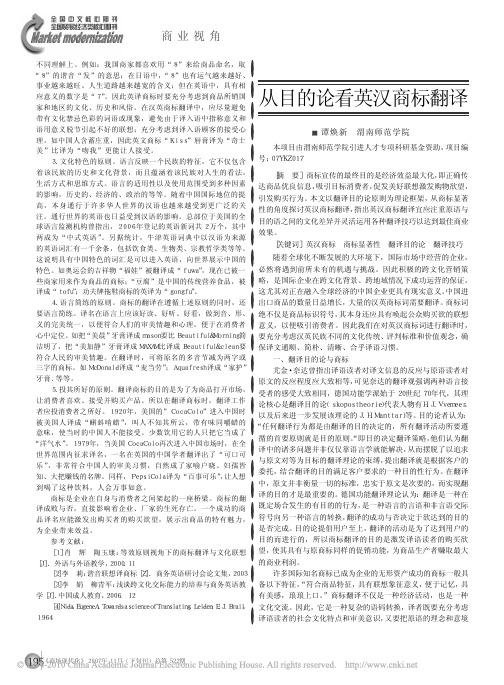
195《商场现代化》2007年11月(下旬刊)总第522期不同理解上。
例如:我国商家都喜欢用“8”来给商品命名,取“8”的谐音“发”的意思;在日语中,“8事业越来越旺、人生道路越来越宽的含义;但在英语中,具有相应意义的数字是“7”。
因此英译商标时要充分考虑到商品所销国家和地区的文化、历史和风俗。
在汉英商标翻译中,应尽量避免带有文化禁忌色彩的词语或现象,避免由于译入语中指称意义和语用意义脱节引起不好的联想;充分考虑到译入语顾客的接受心理。
如中国人含蓄庄重,因此英文商标“Kiss”唇膏译为“奇士美”比译为“吻我”更能让人接受。
3.文化特色的原则。
语言反映一个民族的特征,它不仅包含生活方式和思维方式。
语言的适用性以及使用范围受到多种因素的影响,历史的、经济的、政治的等等。
随着中国国际地位的提高,本身通行于许多华人世界的汉语也越来越受到更广泛的关注。
通行世界的英语也日益受到汉语的影响。
总部位于美国的全球语言监测机构曾指出,2006年登记的英语新词共2万个,其中两成为“中式英语”。
另据统计,牛津英语词典中以汉语为来源这说明具有中国特色的词汇是可以进入英语,向世界展示中国的特色。
如奥运会的吉祥物“福娃”被翻译成“fuwa”,现在已被一些商家用来作为商品的商标;“豆腐”是中国的传统营养食品,被译成“tofu”;功夫牌拖鞋商标的英译为“gongfu”。
4.语言简练的原则。
商标的翻译在遵循上述原则的同时,还义的完美统一,以便符合人们的审美情趣和心理,便于在消费者心中定位。
如把“美晨”牙膏译成mason要比Beautiful&Morning简洁明了,把“美加静”牙膏译成MAXAM比译成Beautiful&clean要符合人民的审美情趣。
在翻译时,可将原名的多音节减为两字或三字的商标。
如McDonald译成“麦当劳”;Aquafresh牙膏.等等。
让消费者喜欢、接受并购买产品。
所以在翻译商标时,翻译工作者应投消费者之所好。
从目的论的角度探讨英语广告的汉译
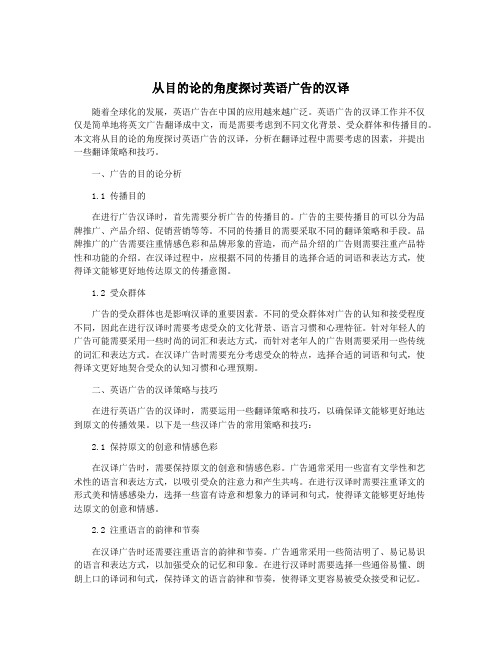
从目的论的角度探讨英语广告的汉译随着全球化的发展,英语广告在中国的应用越来越广泛。
英语广告的汉译工作并不仅仅是简单地将英文广告翻译成中文,而是需要考虑到不同文化背景、受众群体和传播目的。
本文将从目的论的角度探讨英语广告的汉译,分析在翻译过程中需要考虑的因素,并提出一些翻译策略和技巧。
一、广告的目的论分析1.1 传播目的在进行广告汉译时,首先需要分析广告的传播目的。
广告的主要传播目的可以分为品牌推广、产品介绍、促销营销等等。
不同的传播目的需要采取不同的翻译策略和手段。
品牌推广的广告需要注重情感色彩和品牌形象的营造,而产品介绍的广告则需要注重产品特性和功能的介绍。
在汉译过程中,应根据不同的传播目的选择合适的词语和表达方式,使得译文能够更好地传达原文的传播意图。
1.2 受众群体广告的受众群体也是影响汉译的重要因素。
不同的受众群体对广告的认知和接受程度不同,因此在进行汉译时需要考虑受众的文化背景、语言习惯和心理特征。
针对年轻人的广告可能需要采用一些时尚的词汇和表达方式,而针对老年人的广告则需要采用一些传统的词汇和表达方式。
在汉译广告时需要充分考虑受众的特点,选择合适的词语和句式,使得译文更好地契合受众的认知习惯和心理预期。
二、英语广告的汉译策略与技巧在进行英语广告的汉译时,需要运用一些翻译策略和技巧,以确保译文能够更好地达到原文的传播效果。
以下是一些汉译广告的常用策略和技巧:2.1 保持原文的创意和情感色彩在汉译广告时,需要保持原文的创意和情感色彩。
广告通常采用一些富有文学性和艺术性的语言和表达方式,以吸引受众的注意力和产生共鸣。
在进行汉译时需要注重译文的形式美和情感感染力,选择一些富有诗意和想象力的译词和句式,使得译文能够更好地传达原文的创意和情感。
2.2 注重语言的韵律和节奏在汉译广告时还需要注重语言的韵律和节奏。
广告通常采用一些简洁明了、易记易识的语言和表达方式,以加强受众的记忆和印象。
在进行汉译时需要选择一些通俗易懂、朗朗上口的译词和句式,保持译文的语言韵律和节奏,使得译文更容易被受众接受和记忆。
从“目的论”看化妆品商标的翻译-文档资料

从“目的论”看化妆品商标的翻译-文档资料从“目的论”看化妆品商标的翻译近年来各种化妆品品牌越来越受到人们的关注。
高质量的商标翻译,实现规范化、可读性强的译名能够使产品深入消费者心理,激发美好的想象,促进购买欲望,对提升企业知名度开拓市场起着至关重要的作用。
商标名称的翻译涉及到语言规律、文化心理、审美情趣等方面的因素,而并非语言之间的简单转换, 具有自己的内在特点与要求。
本文拟从“目的论”,即功能翻译理论为指导重点探讨化妆品商标名称的翻译,旨在找出其翻译的一般及特殊方法,为品牌更好地走入市场提供一定参照。
一、功能目的论的主要思想20世纪70年代,德国出现一派翻译理论――功能派翻译理论。
它以译文目的为翻译过程的第一准则,发展了功能派的主要理论:目的论。
费米尔(Vermeer)所提出的目的论(Skopos Theory)是功能派翻译理论中最重要的理论。
费米尔认为翻译是一种转换,在这种转换中,言语的和非言语的交际符号从一种语言转换成另一种语言,因而翻译也是一种人类行为。
在其目的论的理论框架中,决定翻译目的的最重要因素便是受众――译文预期的接受者,他们有自己的文化背景知识、对译文的期待以及交际需求。
翻译是在“目的情境中为某种目的及目的受众而产生的语篇”(Vermeer 1987:29)。
诺德(Christiane Nord)进一步完善了目的论。
在诺德这里,翻译是一种有意图的、人际的、以源文本为基础的、口头形式的跨文化交际(诺德,2005:23),目标读者是目标文本创作中的一个决定性因素(诺德,2005:27)。
而翻译策略的选择都是依翻译所服务的目的而定。
功能派创造性地提出的目的性原则,要求翻译活动必须依据翻译目的,以文本目的为翻译过程的第一准则使得翻译更贴近产品实际需求,迎合预期受众,即消费者的心理,对化妆品商标翻译具有重要的指导意义。
功能翻译理论将翻译看作“是一种目的性行为”,认为翻译应以目标语、目标文化为基准的原则以及文本类型决定翻译策略的思想,为翻译理论研究与翻译实践开辟了一个新的视角,为一些非常规的翻译策略、方法比如改译、改写等提供了理论依据。
- 1、下载文档前请自行甄别文档内容的完整性,平台不提供额外的编辑、内容补充、找答案等附加服务。
- 2、"仅部分预览"的文档,不可在线预览部分如存在完整性等问题,可反馈申请退款(可完整预览的文档不适用该条件!)。
- 3、如文档侵犯您的权益,请联系客服反馈,我们会尽快为您处理(人工客服工作时间:9:00-18:30)。
尤金 . 奈达 Eugenne . N id a( 1964 , 19期目的灵活选择各 种翻译方法。
[ 10 ]
指出: 译语读者对译文信息的反应应与原语读者对 原文的反应程度应大致相等。可见奈达的翻译观强 调的是两种语言的接受者的感受大致相同 , 追求的 是 等效。中 国 许多 学 者 如肖 辉、 陶玉 康 兴
恩施职业技术学院学报 ( 综合版 ) Journa l o f Enshi T echnical Co llege ( Comprehen sive Ed it ion )
第 19 卷第 2 期 2007 年第 2 期 No. 2 Vo. l 19 ( No . 2 2007 )
浅谈目的论观照下的英汉商标翻译技巧
康灿辉
( 湘潭大学 外国语学院 , 湖南 湘 潭 412007) 摘要 : 不同于奈达提出的动态对等翻译原 则 , 德 国功能 学派的 翻译目 的论为 商标翻译 研究开 启了全 新的视 角 。 以翻译目的论的原理为理 论框架 , 从商标翻译的 目的性 出发 , 英汉 商标翻译 宜灵活 运用直 译 、 音译和 意译等翻 译技 巧。 关键词 : 商标 ; 目的论 ; 文化认同 ; 文化差异 ; 直译 ; 音译 ; 意译 中图分类号 : H 059 文献标识码 : A 文章编号 : 0000- 2011 /ES( 2007) 02- 0073- 04
收稿日期 : 2006- 11- 23 作者简介 : 康灿辉 ( 1974- ), 女 , 湖南工业大学外语系讲师。研究方向 : 外国语言学及应用语言学。
73
者看到这些商标名称 , 自然产生积极联想 , 从而激起 购买欲望, 达到较好的商业效果。 3 . 商标设计者根据商品的特点和功能, 抓住不 同消费者的消费心理 , 利用各种构词法如缩略、 组合 等自 创词 汇。英 文商 标 如 I N TEL 电 脑 芯片 , M i crosoft软件 , Dutch L ady 乳品等等 ; 中文商标如 蓝 猫 童装 , 大白兔 奶糖, 娃哈哈 饮料等等。 二、 英汉商标翻译的目的论原则及其翻译技巧 德国功能翻译理论认为 , 翻译是一种在既定场 合发生的有目的的行为 , 是一种语言的言语和非言 语交际符号向另一种语言的转换。翻译的成功与否 决定于欲达到的目的是否完成, 讲究翻译目的的完 备性, 而不是对等 , 对等翻译只是翻译多种形式的一 种。据此提出翻译的目的法则 ( skopos rule) , 即 翻 译行为所 要 达到 的 目的 决 定整 个 翻译 行 为 的过 程 , 也就是 结果决定方法, 目的决定手段 。这里 所说的 目的 有三层含义 : 译者的主观目的, 译文 的预期目的 , 采取某种翻译手段的动机目的。目的 论中另外还有两个从属原则 ! ! ! 连贯性法则和忠实 性法则。前者是指 译文必须符合语内连贯 ( in tra textual coherence) 的标准 , 后者是 指 原文与译文 间应存在语 际连 贯一致 ( in tertex tua l coherence ) 。 目的法则的提出 , 实际上引入了翻译的多元化标准。 因为目的不同, 实际操作不同。 H ans. J. V er m eer 是 目的论 ( Skopostheorie / skopos theory ) 的创 始 人之 一 , 他认为目的法则是: 每个文本为某个目的所生 产 , 并应该服务于该目的。译文的接收者是决定翻 译目的的重要因素之一。笔译、 口译、 讲话和写作必 须让你的文本在使用场合能对想使用的人起作用 , 并按照想使用的人所想起作用的方式起作用。根据 不同情况有不同的从属法则 , 这些法则来自翻译要 求 , 它是由发起人 ( in itiator) (也可能是译者本人 ) 给 定的。至于原文 , 他们认为只是一种信息源, 因为任 何翻译都是面对意向受众 , 功能策略便可以解决翻 译问题。 No rd( 1997 : 74) 还提出 , 假如翻译目的是 令目的受众达到某种功能的话, 任何阻碍达到这种 目的的东西都是翻译失误 。功能翻 译派认为, 翻 译行为牵涉到发起者 ( 真正需要译文的人 )、 委托人 ( comm issio ner , 让译者为某个目的和具体收受者而 生产译文的人 )、 原文生产者 ( source- tex t producer , 往往只间接地参与, 仅仅提供了原文的特征 )、 译者 ( 可以认为是一个目的文化文本生产者, 表达原文 化发送者的交际意图 ) 、 译文使用者 ( target- text us er) 、 译文接收者 ( target - tex t rece iv er)、 译文收受 者 ( target text addressee , 译文的收受者 , 是生产译 74
[ 11]
、 李克
、 蒋磊
[ 5]
、 李莹
[ 6]
、 刘汝荣
[ 7]
、 何霜
[ 8]
等以此为
理论基础, 对商标翻译进行探索 , 但把目的论用于指 导商标翻译实践的论文却很难看到。德国功能学派 始于 20 世纪 70 年 代, 其 理论 核心是 翻译目 的论 ( Skopostheorie), 代表人物有 K. R eiss和他的学生 H. J . Ver m eer以及后来进一步发展该理论的 J. H. M anttari和 C. Nord等。目的论者认为: 任何翻译 行为都是由翻译的目的决定的, 所有翻译活动所要 遵循的首要原则就是目的原则, 即目的决定翻译策 略 。 ( Nord , 2001)
[ 15 ] [ 12]
孚日 的文化内涵为 诚信每一天 , 其译名为 Sun vi m, 英语中的文化内涵为 活力十足 。这个商标 既能体现公司生机勃勃蒸蒸日上的发展态势 , 又以 通俗易懂感染力强的词汇激起消费者的共鸣 , 得到 消费者的认同。 这类 中国品牌 商标翻 译比比皆 是。如蜂花 (护发素 ) 指使用该产品后将如鲜花般 芳香宜人; 喝王朝 Dynasty( 葡萄酒 )能享受到中国帝 王般的待遇。这类翻译保留了原语在语音语义上的 美感, 符合东西方文化观念和逻辑思维。汉语商标 大多采用直译。 英雄 (墨水和钢笔名 ) 和 钻石 ( 手表 ) 分别直译成 H ero 和 D iam ond 。这些译名都 较好地忠实反映原商标名 , 达到和原文同样的促销 目的。 2 . 英语商标直译成汉语 用做商标的轿车直译为 蓝鸟 , 典出比利时作 家 1911 年 (获诺贝尔文学奖 ) 的童话剧。剧中象征 未来幸福 , 用做轿车的商标, 转义为 幸福之源 。 唐朝李商隐有诗云: 蓬山此去多无路, 青鸟殷勤为 探看 。 青鸟 乃蓬山仙境的使者, 且汉语的 青 和 蓝 皆可等同于英语的。 蓝鸟 二字不仅读来 琅琅上口 , 文化 内涵也很相似。 ( 许金杞, 2002) 又 如将 Crow n 译为 皇冠 , 英汉商标均暗示了它们所 代表商品的高贵形象。 Apple( 电脑 )译为 苹果 则 有人人喜爱 , 人人需要之意。 (二 )英汉商标翻译中的文化认同和音译 音译就是在不违背译语语言规范和不引起错误 联想的前提下, 按其发音, 将商标用与之语音接近的 字词进行翻译的方法。由于文化共性的存在 , 汉英 两种词汇和表达在发音内容和形式上可能相同或相 似 , 双方不但有相似的文化内涵和修辞色彩, 还能带 给人美好的联想。这时可采用音译法以忠实于原商 标的呼唤功能, 保留各自商标的音韵之美。 1 . 汉语商标音译成英语 国内最大的 娃哈哈 W ahaha 饮料公司前些年 推出一款名为 非常可乐 的饮料, 音译成 Future co la , 似 乎预示中国人 也有自己的可 乐, 而 且非常可 乐 , 从而对美国的两大饮料巨头可口可乐和百事可 乐提出挑战 , 暗示做未来最好的可乐的决心。这类 译法被广泛地应用于汉语商标翻译。如 昂 立 On ly, 华帝 - V antage , 乐百氏 - Robus, t 托普 软件 - T op , 等等。 2 . 英语商标音译成汉语 美国一化妆品牌 Rev lon 被音译成 露华浓 , 该词取自唐代诗人李白描写杨贵妃花容月貌的名诗 ∀清平调三章 #之一: 云想衣裳花想容 , 春风拂槛露
[ 9]
他们认为翻译中的诸多问题
并非仅仅靠语言学就能解决 , 从而摆脱了以追求与 原文对等为目标的翻译理论的束缚, 提出翻译就是 根据客户的委托 , 结合翻译的目的满足客户要求的 一种目的性行为。在翻译中 , 原文并非衡量一切的 标准, 忠实于原文是次要的 , 而实现翻译的目的才是 最重要的。 Ver m eer指出: 译者在整个翻译过程中 的参照系数不应是对等理论中所注重的原文及其功 能 , 而应是译文在译语文化环境中所期望达到的一 种或几种交际功能。因此 , 译文并不一定要机械地
文的决定因素 ) 。收受者是文本生产者臆想的接收 者, 而接收者是真 正读或听过生 产出的文本的人。 Eugenne . N id a是中国翻译理论界中被介 绍和研究 得最早、 最多的一位美国译论家。他认为绝对一致 的翻译是不存在的 , 译者寻求的应当是译文和原文 的 对等 ( equ iv alence) ; 翻译只能尽量忠实准确地 用译语形式把原语的思想内容、 风格、 神韵等再现出 来, 尽可能使译文读者的感受和反映与原文读者的 感受和反映一致。很少有人想过 , 他的翻译理论实 际上是 ∀圣经 #翻译理论, 并非放之四海而皆准的普 通翻译理论。 商标是商品生产者或经营者为了使自己的商品 与他人的商品相区别而使用的一种具有显著性的标 记, 其功能在于识别商品提供商品信息宣传商品刺 激消费。这种标记通常用文字或图形单独构成 , 或 [ 13] 是文字和图形共同构成。 商标如同人名 , 是代表 商品的符号。它既要符合审美心理 , 又要力求创新。 许多国际知名商标已成为企业的无形资产。成功的 商标一般具备以下特征 : 符合商品特征 ; 具有联想象 [ 14] 征意义 ; 便于记忆, 具有美感, 琅琅上口。 商标翻 译不仅是一种经济活动 , 也是一种文化交流 ; 因此 , 它是一种复杂的语码转换, 译者既要充分考虑译语 读者的社会文化特点和审美意识 , 又要把原语的理 念和意境表达 出来 , 只有 这样 才能达 到促 销的 目 的。 笔者认为: 翻译的目的决定了翻译的手段, 同 时也就决定了翻译技巧的选择。商标翻译的目的是 激发译入语读者的购买欲望, 使其具有与原商标同 样的促销功能 , 为商品生产者赚取最大的商业利润。 根据这一目的论原则, 实际翻译中可灵活采用直译、 音译和意译等翻译技巧。 ( 一 ) 英汉商标翻译中的文化认同和直译 直译就是在翻译过程中, 把词看成翻译的基本 单位 , 同时考虑语境的制约, 保留原商标的意义和结 构, 再现其形式内容和风格, 既最大限度地获得与原 商标同等的广告效果 , 又保持原商标的美感。商标 翻译必须充分考虑彼此的文化现象 , 文化通过商品 传播 , 商品通过文化增值。中西文化相互渗透, 汉英 两种语言在意义形象和文化色彩上有很多一致性。 在此情况下, 英汉商标宜采用直译或音译的方法 , 既 忠实于原商标的含义, 又能被译语消费者接受。 1 . 汉语商标直译成英语 中国名牌企业山东洁玉纺织股份有限公司更名 为孚日家纺股份有限公司。 孚 字取自 ∀诗经大雅 下武 # 永言配 命, 成王之 孚 , 意 为 诚 实守 信 ; 日 字的基 本义为 一 天 或 太 阳 , 象 征永恒。
